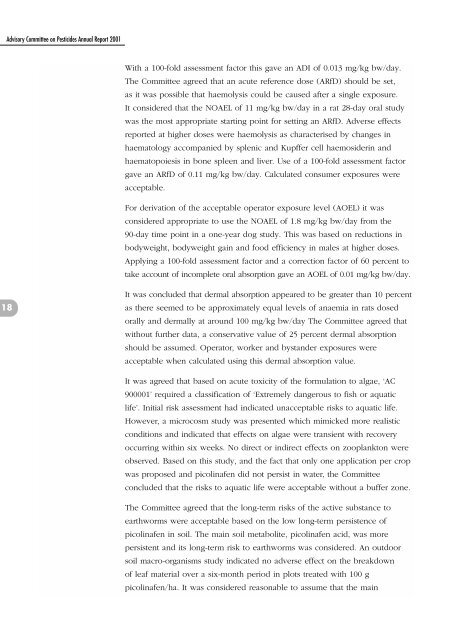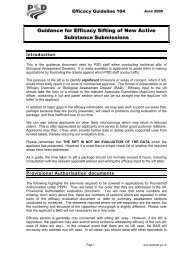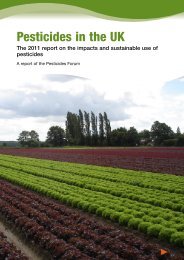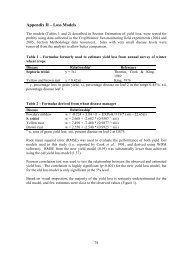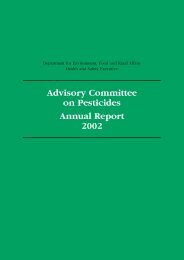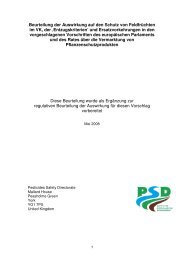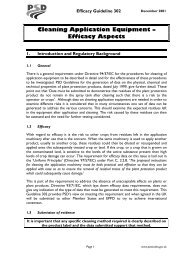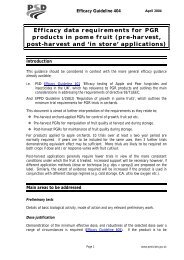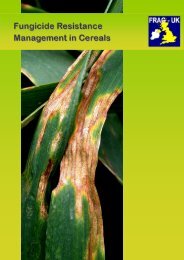Advisory Committee on Pesticides Annual Report 2001
ACP Annual Report 2001 - Pesticides Safety Directorate
ACP Annual Report 2001 - Pesticides Safety Directorate
Create successful ePaper yourself
Turn your PDF publications into a flip-book with our unique Google optimized e-Paper software.
<str<strong>on</strong>g>Advisory</str<strong>on</strong>g> <str<strong>on</strong>g>Committee</str<strong>on</strong>g> <strong>on</strong> <strong>Pesticides</strong> <strong>Annual</strong> <strong>Report</strong> <strong>2001</strong><br />
With a 100-fold assessment factor this gave an ADI of 0.013 mg/kg bw/day.<br />
The <str<strong>on</strong>g>Committee</str<strong>on</strong>g> agreed that an acute reference dose (ARfD) should be set,<br />
as it was possible that haemolysis could be caused after a single exposure.<br />
It c<strong>on</strong>sidered that the NOAEL of 11 mg/kg bw/day in a rat 28-day oral study<br />
was the most appropriate starting point for setting an ARfD. Adverse effects<br />
reported at higher doses were haemolysis as characterised by changes in<br />
haematology accompanied by splenic and Kupffer cell haemosiderin and<br />
haematopoiesis in b<strong>on</strong>e spleen and liver. Use of a 100-fold assessment factor<br />
gave an ARfD of 0.11 mg/kg bw/day. Calculated c<strong>on</strong>sumer exposures were<br />
acceptable.<br />
For derivati<strong>on</strong> of the acceptable operator exposure level (AOEL) it was<br />
c<strong>on</strong>sidered appropriate to use the NOAEL of 1.8 mg/kg bw/day from the<br />
90-day time point in a <strong>on</strong>e-year dog study. This was based <strong>on</strong> reducti<strong>on</strong>s in<br />
bodyweight, bodyweight gain and food efficiency in males at higher doses.<br />
Applying a 100-fold assessment factor and a correcti<strong>on</strong> factor of 60 percent to<br />
take account of incomplete oral absorpti<strong>on</strong> gave an AOEL of 0.01 mg/kg bw/day.<br />
18<br />
It was c<strong>on</strong>cluded that dermal absorpti<strong>on</strong> appeared to be greater than 10 percent<br />
as there seemed to be approximately equal levels of anaemia in rats dosed<br />
orally and dermally at around 100 mg/kg bw/day The <str<strong>on</strong>g>Committee</str<strong>on</strong>g> agreed that<br />
without further data, a c<strong>on</strong>servative value of 25 percent dermal absorpti<strong>on</strong><br />
should be assumed. Operator, worker and bystander exposures were<br />
acceptable when calculated using this dermal absorpti<strong>on</strong> value.<br />
It was agreed that based <strong>on</strong> acute toxicity of the formulati<strong>on</strong> to algae, ‘AC<br />
900001’ required a classificati<strong>on</strong> of ‘Extremely dangerous to fish or aquatic<br />
life’. Initial risk assessment had indicated unacceptable risks to aquatic life.<br />
However, a microcosm study was presented which mimicked more realistic<br />
c<strong>on</strong>diti<strong>on</strong>s and indicated that effects <strong>on</strong> algae were transient with recovery<br />
occurring within six weeks. No direct or indirect effects <strong>on</strong> zooplankt<strong>on</strong> were<br />
observed. Based <strong>on</strong> this study, and the fact that <strong>on</strong>ly <strong>on</strong>e applicati<strong>on</strong> per crop<br />
was proposed and picolinafen did not persist in water, the <str<strong>on</strong>g>Committee</str<strong>on</strong>g><br />
c<strong>on</strong>cluded that the risks to aquatic life were acceptable without a buffer z<strong>on</strong>e.<br />
The <str<strong>on</strong>g>Committee</str<strong>on</strong>g> agreed that the l<strong>on</strong>g-term risks of the active substance to<br />
earthworms were acceptable based <strong>on</strong> the low l<strong>on</strong>g-term persistence of<br />
picolinafen in soil. The main soil metabolite, picolinafen acid, was more<br />
persistent and its l<strong>on</strong>g-term risk to earthworms was c<strong>on</strong>sidered. An outdoor<br />
soil macro-organisms study indicated no adverse effect <strong>on</strong> the breakdown<br />
of leaf material over a six-m<strong>on</strong>th period in plots treated with 100 g<br />
picolinafen/ha. It was c<strong>on</strong>sidered reas<strong>on</strong>able to assume that the main


